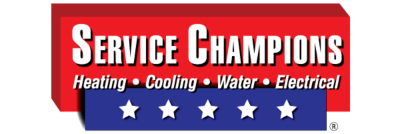Go Over This Home Safety Checklist for Building Safety Month

May 19, 2017
May is Building Safety Month. Founded by the International Code Council, Building Safety Month “is a public awareness campaign to help individuals, families and businesses understand what it takes to create safe and sustainable structures” (ICC).
Safe and sustainable structures are a worldwide priority. Where we live and work and play should be up-to-code and built with strong design and safety in mind. For 37 years, the campaign has reinforced “the need for adoption of modern, model building codes, a strong and efficient system of code enforcement and a well-trained, professional workforce to maintain the system.” Improving public safety is the biggest aim of this organization.
Knowing if your home is up-to-code and prepared to withstand any potential natural disaster is important. Service Champions offers this Home Safety Checklist in honor of Building Safety Month.
HVAC Maintenance
According to the National Fire Protection Association, air-conditioning, fans, and related equipment were involved in around 7,200 home structure fires in the U.S. between 2006 and 2010.
Avoid these A/C home fire risks by scheduling bi-annual maintenance for your HVAC units—once in the fall for your heating system and once in the spring for your cooling system. This ensures safe and efficient use of your home’s largest energy-consumers.
Regular maintenance ensures that any lurking hiccups can be caught and repaired before they turn into costly and dangerous problems. Additionally, make sure you replace your filters every 30-90 days.
Annual professional maintenance should also be scheduled for your plumbing and electrical systems. Only hire certified professionals for HVAC, plumbing, and electrical work. These systems must be repaired and installed according to state and federal codes. Avoid “handymen” and jacks-of-all tradesmen.
Additional HVAC safety tips include:
- Always follow manufacturer instructions.
- Regularly inspect and maintain all equipment.
- Select equipment for safety and effectiveness (make sure equipment has a label showing it has been listed by an independent testing laboratory).
May is also Electrical Safety Month. Learn how to ensure electrical safety for your HVAC system.
Smoke & Carbon Monoxide Detectors
Hundreds of residential fires could be prevented every year if there were functioning smoke alarms. Additionally, 2/3 of all fire deaths occur in homes without functioning smoke detectors.
Carbon monoxide is a “silent killer” because it has no smell, only noticeable side effects. CO alarms are the only way to detect this potentially fatal gas.
Ensure your family is safe from smoke and gases by holding down the “test” button on your devices every 30 days. Every home should have smoke and CO detectors installed on every floor of the home and outside of every sleeping area.
Make sure you change your smoke and CO detectors batteries at least once a year. Never ignore the chirping sound coming from your detectors. This indicates a low battery that needs to be replaced. Change all smoke and CO detectors after 10 years.
For more information on smoke and CO safety, visit our smoke alarm and CO detector pages.
Additional Fire Prevention Tips
Never smoke indoors.
If there are any smokers in the household, it’s a good idea to make it a house rule to only smoke outdoors. Never smoke in bed or on a couch. Avoid smoking when you are drowsy.
Never throw out lit cigarettes. Have deep, sturdy ashtrays available for smokers and make sure they are wet or buried in sand before throwing them out.
Maintain a minimum 3-foot clearance around all space heaters, fireplaces, and furnaces.
Keep anything that could burn at least 3 feet away from any heat-producing appliance, including fireplaces and stoves. Teach children that these areas are no-play zones.
Remember to turn off all space heaters, stoves, fireplaces, and candles before leaving the room or going to bed. Always plug space heaters directly into outlets and never into extension cords or power strips.
Inspect electrical cords and devices for damage.
Stop using and replace all frayed, cracked, and damaged cords and electrical devices. Consult a professional about repair. Never try to repair electrical products yourself.
Never run electrical cords in high-traffic areas, under rugs, or where they can be pinched by windows and doors. Do not use staples to attach wires to walls or ceilings.
Keep a working phone in the bedroom.
Keep a phone close to your bed in the event of an emergency. Make sure you have local emergency numbers posted near your phones, including the local fire department and hospital.
Prepare Your Family for Anything
Does your family have an emergency escape plan? You and your children should all know what to do and where to go in case of an emergency. If there is a home fire or natural disaster, you’ll be very thankful that you have practiced your escape route.
Food, supplies, important documents, phone numbers, medical insurance, and an evacuation route are all life-saving precautions every family should have. Whether it’s a fire or a tornado, know how to get out or where to take shelter, how to communicate, where the supplies are, and how to weather any storm. Fill out this Family Disaster Plan from the Red Cross and attach it to your refrigerator or another easily accessible area.
For more information on preparing for an emergency, visit the American Red Cross and ready.gov.
Contact Service Champions at (925) 444-4444 for more information on residential code compliance, remodeling standards, natural disaster preparation, and HVAC safety.
